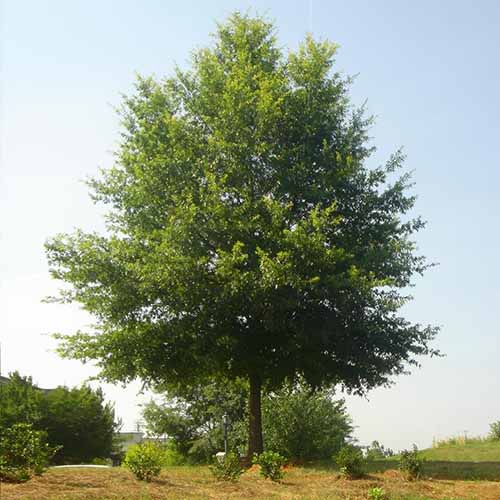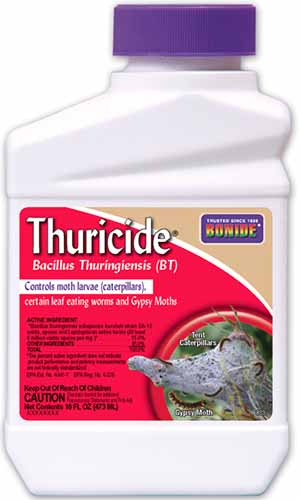Quercus phellos
What would you create if you could cross an oak and a willow? The willow oak!
Not truly a hybrid of the two, it’s an oak through and through, complete with acorns. But you might mistake the narrow leaves for those of a willow.
Willow oak is a favorite of wildlife, making all kinds of birds, as well as squirrels and other herbivores, extremely happy.
Watching the chipmunks and squirrels collect the nuts for storage has to be one of my favorite things to do in the fall.
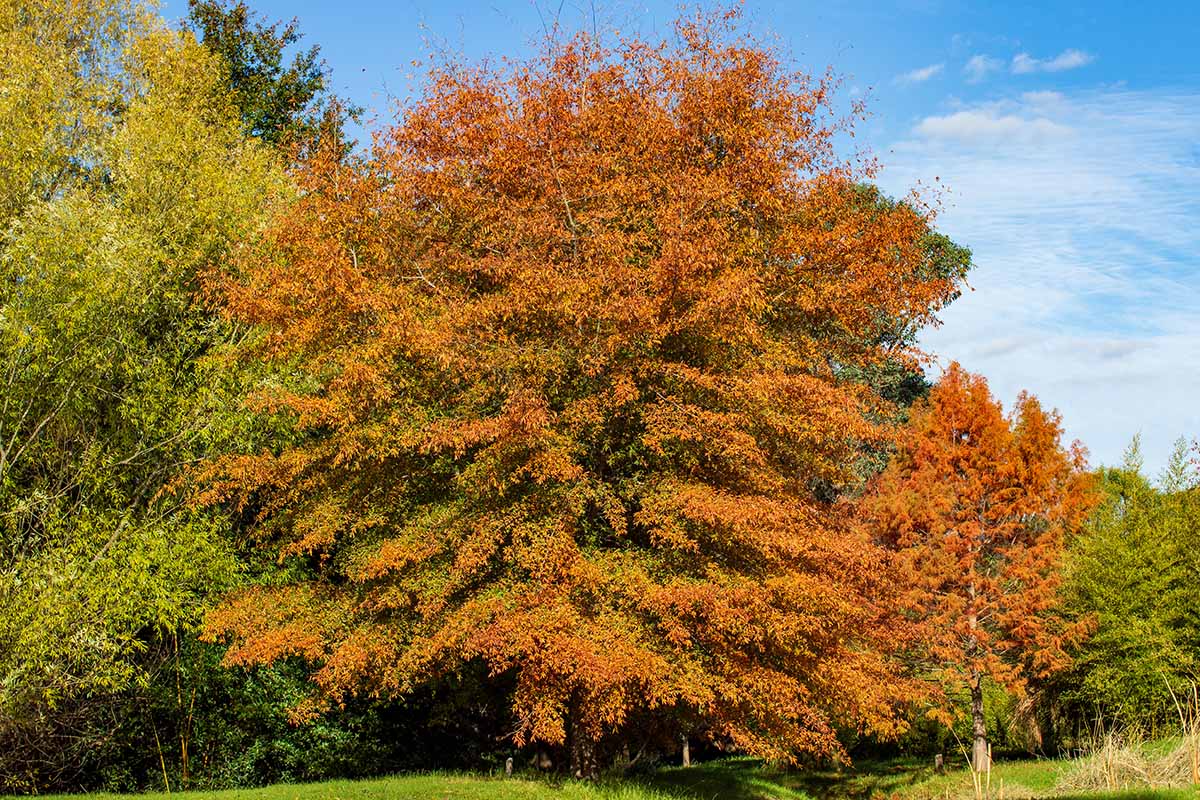
We link to vendors to help you find relevant products. If you buy from one of our links, we may earn a commission.
This isn’t your mother’s oak, though. Well, unless your mother grew one of these.
There are many cultivars that have an upright, narrow growth habit that makes them perfect for parking strips and lots, and planting closer to homes than you might be able to put a tree otherwise.
They’re easy to grow and more resistant to problems than some other species in the Quercus genus, as well.
Let’s talk all things willow oak. Here’s the lineup of what we’ll discuss in this guide:
If you’d like a rundown of all the pros and cons of willow oaks, please visit our guide (coming soon!).
Ready to get growing? Let’s dive in.
Cultivation and History
The willow oak also goes by the names pin, peach, and swamp chestnut oak.
“Quercus” is the Latin word for oak and “phellos” is Latin for cork, a reference to the texture of the bark of older specimens.
But don’t confuse it with Q. suber, which has the common name “cork oak.” The latter is native to Europe and is used to produce the cork you know and love for making boards and sealing wine bottles.
Willow oaks are, as you probably guessed, part of the oak family.
This species is in the red oak group and grows indigenously across the southeastern US and up the eastern seaboard as far north as New Jersey and as far south as northern Florida, and to the west across Texas and Oklahoma.
It’s also grown across the US in USDA Hardiness Zones 5 to 9 as an ornamental.
Willow oaks are an important source of food for wildlife. They grow best in moist locations like low-lying areas, near streams or irrigation ditches, or on the edges of swamps or lakes.
When mature, they can reach over 100 feet tall and half as wide, but most stay about half that size. Larger specimens are rare but not impossible – one in Tennessee measured 123 feet tall and 100 feet wide!
This species does best below about 1,500 feet in altitude.
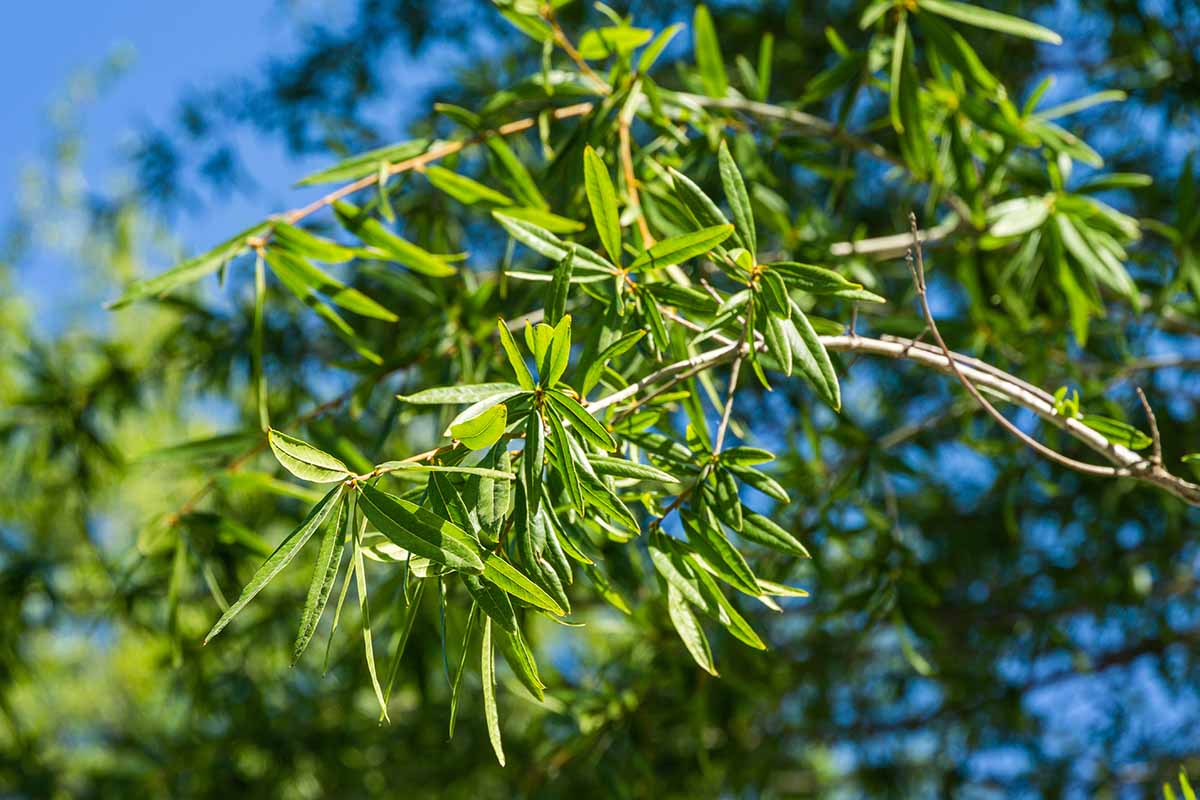
The leaves are smooth, narrow, alternate, and green, with a single bristle at the tip. That little bristle is how you can easily determine that it’s a part of the red oak group.
The leaves typically grow about four to five inches long and an inch wide. Light green in the spring, they change to medium green in the summer.
During the spring, as the leaves are emerging, long greenish-yellow, wind-pollinated catkins form. These plants are monoecious, meaning they have both female and male parts on each tree.
In the fall, the leaves turn golden yellow or brownish-yellow. Unlike those of pin oaks, they don’t persist on the tree until spring, but rapidly drop all at once in the fall, making cleanup easier.
The acorns, which take two years to mature, are some of the smallest in the genus and most fail to grow even to half an inch in length.
Despite their diminutive size, the willow oak is a vigorous producer, which means there are mature acorns available every year, with some on each tree maturing in alternate years for a perpetual annual harvest.
Young specimens have gray bark, which turns dark gray-brown with age and develops deep furrows.
The young seedlings can grow rapidly, up to five feet in two years. From there, this species has a moderate growth rate, slowing down to about a foot per year.
Willow Oak Propagation
Whether you buy a young plant at a nursery or you want to plant an acorn you found, there are several ways to add this plant to your world.
From Seed
Because willow oaks readily hybridize in the wild so propagating seed is unreliable, we don’t recommend this method. But we’ll provide you with the outline of what’s required in case it’s something you’re interested in.
The seeds should be cold stratified at 33 to 40°F for three months before you plant. The easiest way of doing this is to put them in moistened sphagnum moss in the refrigerator. Remove the caps from the acorns first, if they’re still attached.
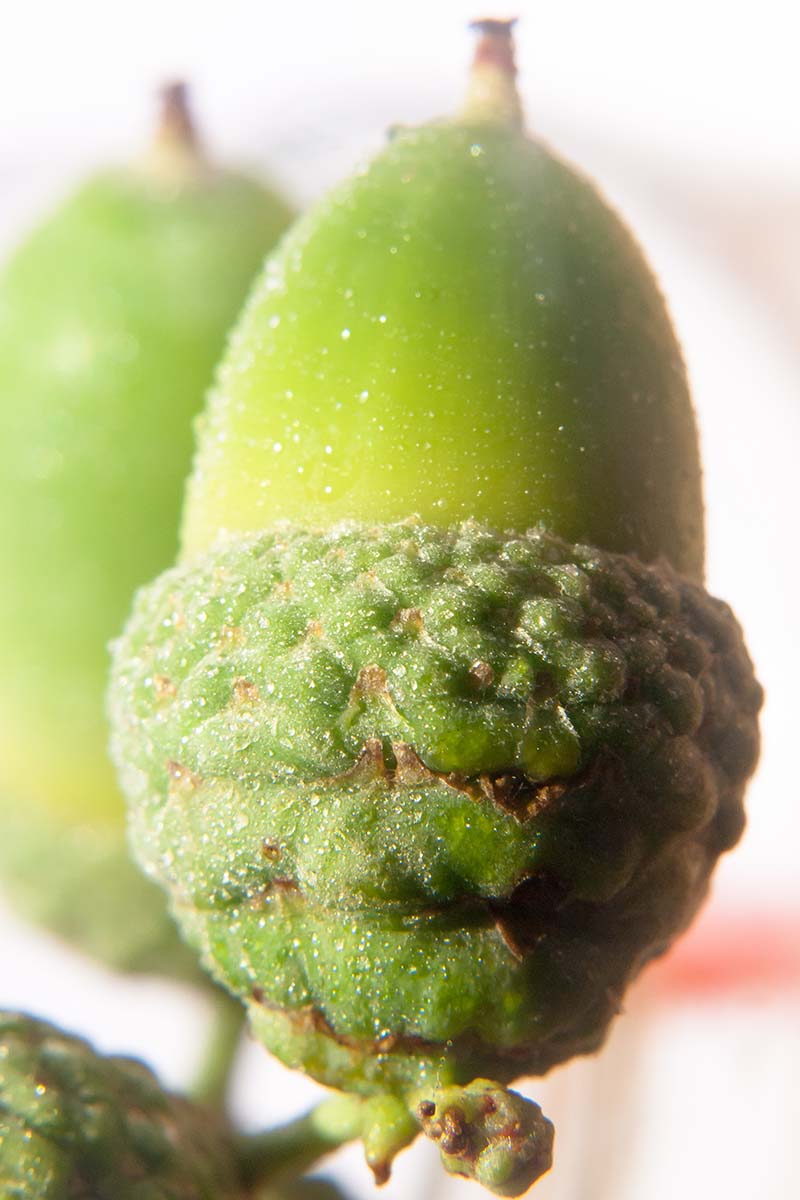
In the spring, when the days are consistently above freezing, prepare a seedbed with lots of well-rotted compost and plant each acorn.
Sink each seed about two inches deep and place three or four in each area to ensure at least one germinates.
The seeds can be planted about two feet apart if you plan to transplant some of the seedlings, or at least 20 feet apart if you intend to leave them in place.
Cover the area with an inch or so of leaf litter. Keep the soil moist but not wet. If multiple seeds germinate in one spot, pull the smaller seedlings.
From Cuttings
True willow (Salix spp.) cuttings are exceptionally easy to root. Oak willow isn’t quite so easy. Consider it a five on a scale of one to 10.
Before you start cutting, work in some well-rotted compost in the area where you want to plant your new willow oak.
Create a hole in the soil a few inches deep using a pencil or chopstick. Create another hole or two a few inches away.
Look for flexible, pencil-sized branches in the spring. Cut a six- to nine-inch-long piece at a 45-degree angle, right below a leaf node, and remove all but one or two leaves at tip.
Take several cuttings for each tree you want to grow.
Dip the cut ends in a rooting hormone like Bontone II Rooting Powder, which you can pick up at Arbico Organics in a one-and-a-quarter-ounce container.
Place a cutting in the hole you made and firm the soil up around it. Proceed with several more nearby. You want to place about three cuttings in each spot, assuming that one will succeed.
Water the soil well and firm it up again if it loosens and causes the cutting to sink or tip.
Keep the soil moist as the cutting develops. There’s no need to do anything but keep the soil moist until you start to see new growth develop.
If multiple cuttings in the same area start growing new leaves, gently pull all but the strongest one, taking care not to disturb the roots of the remaining cutting.
Heap lots of straw or leaf mulch around the cutting to protect it during the winter and remove the protective layer in the spring when new growth starts.
Beginning the next year, you can treat the plant as you would any other sapling.
Transplanting
The best time to transplant is in the late fall, winter, or early spring, when the willow oaks are dormant. Willow oaks have a fibrous root system that lends itself well to transplanting.
First, prepare the area by working in lots of well-rotted compost and digging a hole twice as wide and the same depth as the container your plant came in.
Gently remove the youngster from the container and loosen up the roots. Lower it down into the hole and fill in around it with a compost and soil mixture.
Water well and fill in with more soil if it settles.
You want the plant to be sitting at the same level that it was in the growing medium, with just the root flare where the root ball begins above the soil.
Keep the soil moist to support the tree as it becomes established.
How to Grow Willow Oaks
This is a fairly fast-growing tree, but not so fast that the wood is weak and readily falls apart in the slightest breeze.
If you plant yours in fertile, moist soil, it will grow much larger and faster than it would otherwise, but it can still be a robust, large specimen in less-than-ideal conditions.
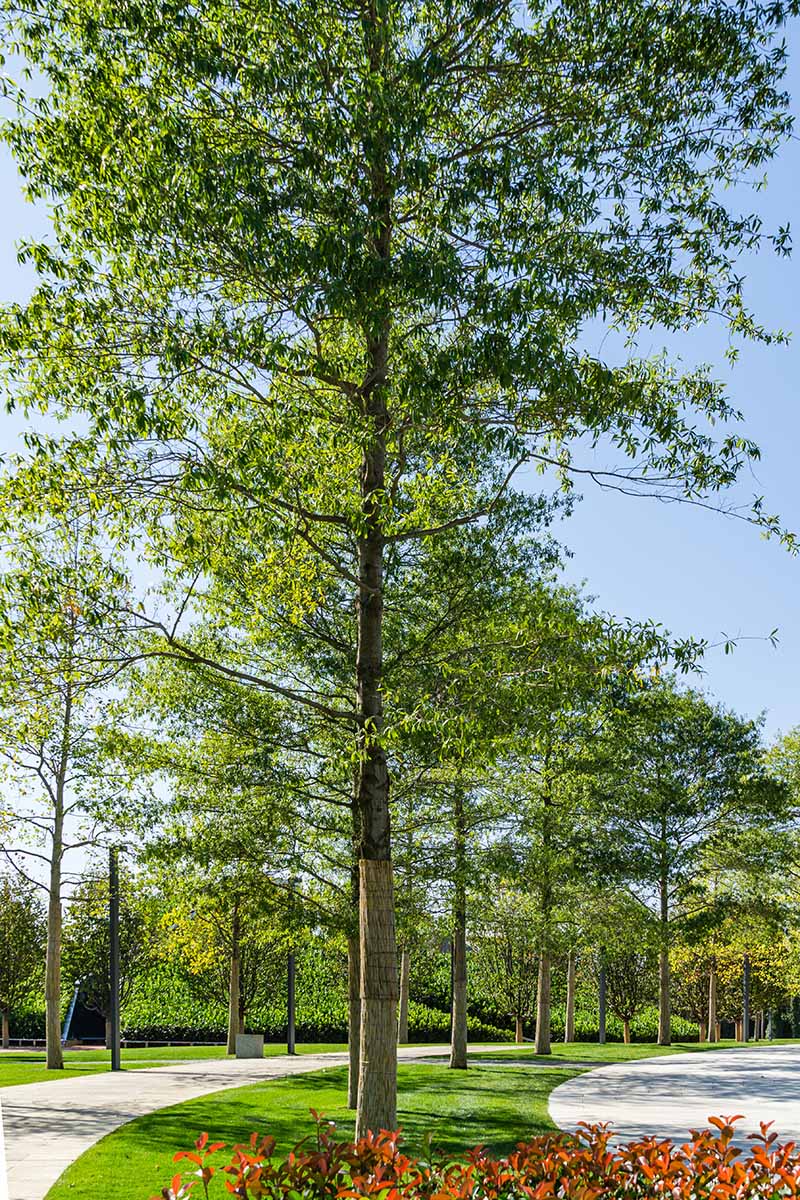
Moisture lovers, saplings will survive up to three months of saturated soil, so if you live somewhere with soggy winters, they will survive where other plants may fail.
Mature willow oaks can even tolerate up to three years of soggy, wet roots.
On the other end of the spectrum, willow oaks will thrive in areas with occasional drought-like conditions once established.
Note that adequate moisture is particularly important for young plants, but overwatering can slow growth.
Aim to keep the soil moist around young plants and then only irrigate established plants during periods of drought.
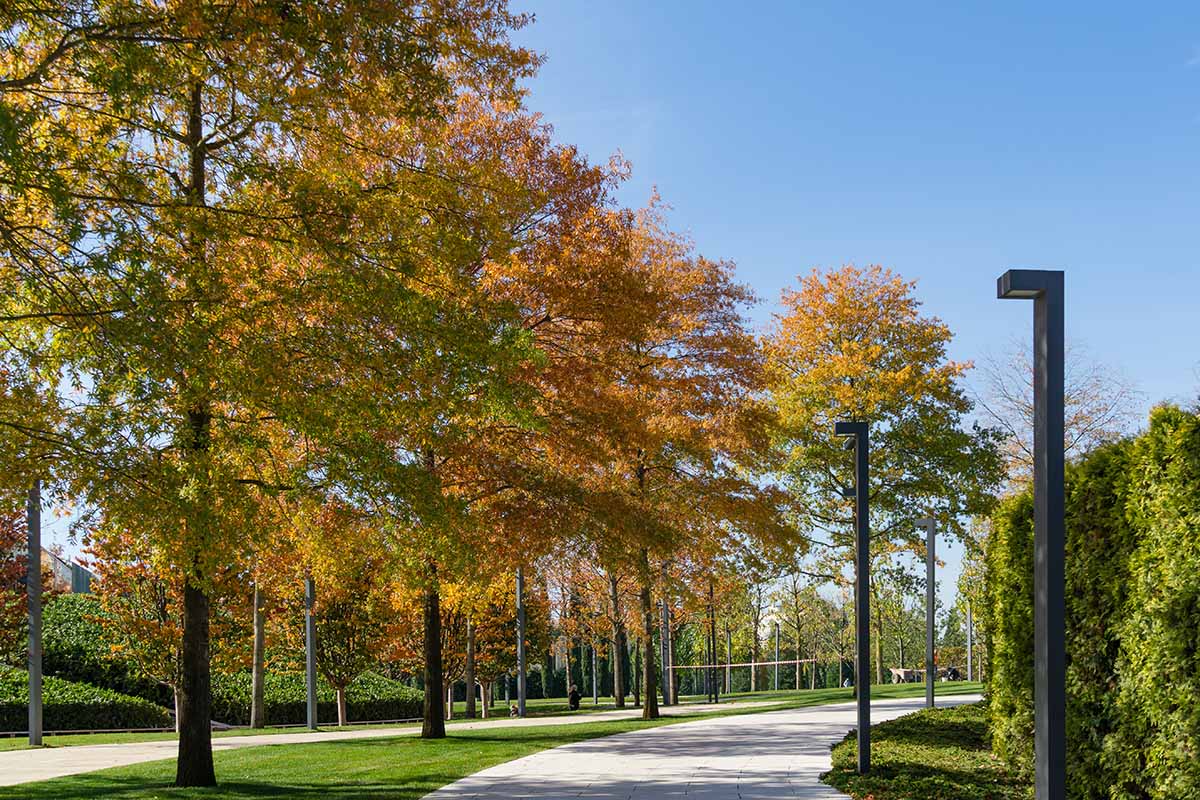
Q. phellos requires acidic soil with a pH of 4.5 to 5.5 and full sun. It can tolerate clay soil, making it a good option if you have heavy earth. It’s also tolerant of pollution.
At about 15 to 20 years after planting, the tree will be mature enough to produce acorns, which is much younger than most oaks.
It’s possible for a late freeze to defoliate the willow oak and kill any flowers.
The tree will recover and grow a second set of leaves, but it won’t develop a second round of catkins. That means no batch of acorns.
There’s no need to feed your willow oak unless a soil test reveals a deficiency. You do an annual soil test, right?
Growing Tips
- Plant in full sun.
- Keep the soil moist for trees under five years old.
- Water during times of drought for older specimens.
- Fertilize only if your soil has a deficiency.
Pruning and Maintenance
It’s important to prune young willow oaks to encourage a healthy, sturdy central leader.
That means you want a single, main trunk that goes all the way up the center of the tree, rather than several trunks as the canopy expands.
When you first plant your willow oak, trim off any competing trunks so you have one strong, main trunk. Cut the competing trunks off at the base using a pair of pruners or a saw.
From there, it’s a matter of maintenance. When the tree is young, you can remove any crossing or rubbing branches to create shape and open the canopy.
As it gets older, it will probably be too large for you to do this, but feel free to break out a tree saw if you see a problem or consult a professional arborist.
Otherwise, remove any broken, diseased, damaged, or dead branches as you see them.
Willow Oak Cultivars and Hybrids to Select
Depending on where you live, you might only be able to find the species. But there’s nothing wrong with that – the species is incredible!
If you want one of the standard willow oaks, visit Fast Growing Trees for a four- to five-, five- to six-, or six- to seven-foot live specimen.
If you’re interested in some of the cultivars that have been developed in recent years, here are some excellent options:
High Tower
Q. phellos ‘Qpsta’ can stretch up to 65 feet tall and 45 wide. The foliage is darker green than the species.
It has gained a reputation as the ideal landscaping tree near roadways and buildings because it develops a strong central leader naturally, and the branches grow up rather than out, leaving roads and walkways clear for traffic.
The leaves turn bright yellow in the fall. The only downside is that it’s slightly less hardy than the species, suitable for Zones 6 to 9.
Kingpin
‘Greenenvy,’ also known as Kingpin®, was bred by grower Sam Rogers at Bold Spring Nursery in Hawkinsville, Georgia.
Its foliage is dramatically darker than the species and the growth is more upright, with a prominent central leader.
Pillow
‘Pillow’ or pink-willow oak (Q. x schociana) is a hybrid cross between Q. palustris and Q. phellos.
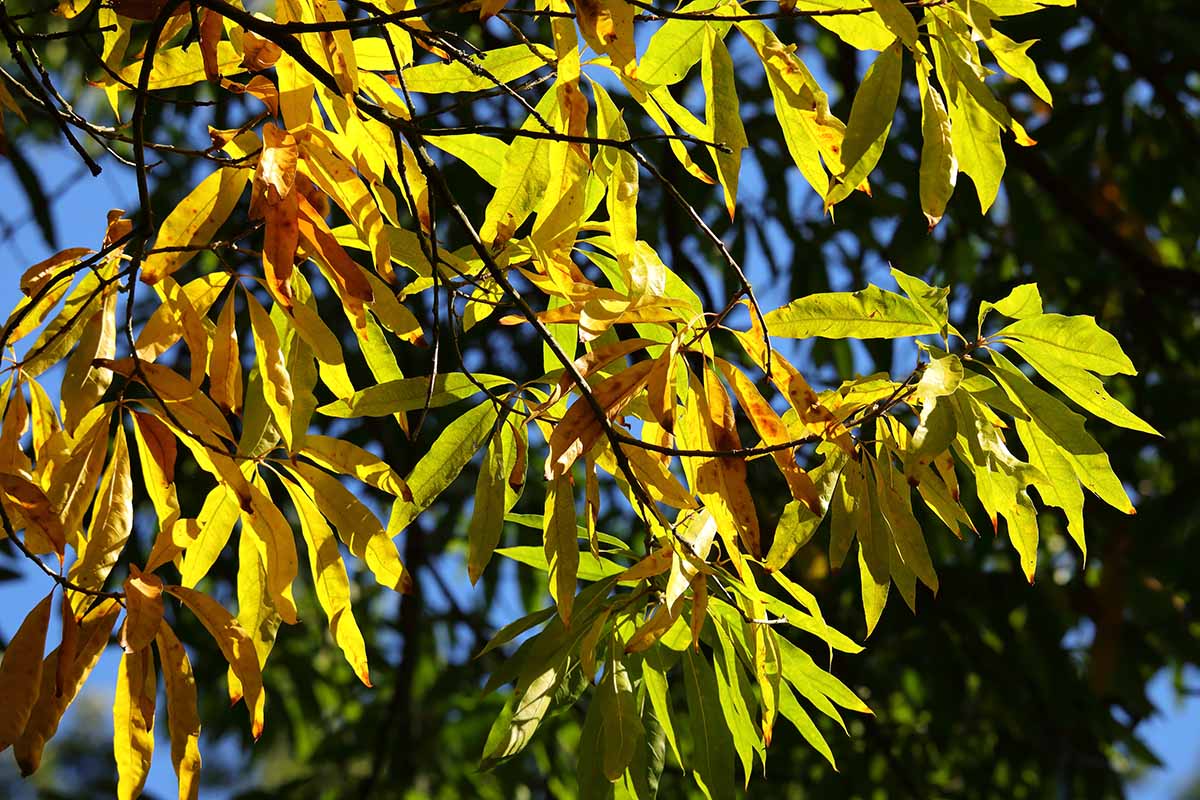
It was found in a German nursery where it was cultivated by Hofgartner Schoch and named by botanist George Dieck in 1887, in honor of its breeder.
It grows to about 50 feet tall with a round crown and much showier, bright red fall foliage than the willow species. New leaves in spring emerge with a hint of pink.
Upperton
Fast-growing, with a strong central leader and an upright growth habit, Upperton® (Q. phellos ‘RT3’) is perfect for parking lots, spaces next to buildings, and areas along roadways.
It was cultivated by Georgia grower Ray Tate after he took a cutting of a promising specimen with prolific, uniform branching that was located in a parking lot island.
When mature it grows 60 feet tall and 40 feet wide and is hardy in Zones 6 to 9.
Wynstar
‘Wynstar’ or ‘QPMTF’ has rusty orange leaves in the fall, making the mature 80-foot tree a dramatic focal point.
It has a more uniform and upright growth habit than the species.
Managing Pests and Disease
Deer will feed on young plants, but once the willow oaks grow large enough, these critters will ignore them.
To learn how to protect your plants until they’re old enough to be safe, check out our guide to managing deer.
Willow oaks are extremely susceptible to acid rain with a pH below 3.2. If you have young trees, protect them during storms and soak the soil afterwards to flush it.
Hogs are extremely fond of the fallen acorns, but they won’t generally bother a mature specimen.
Insects
In general, pests won’t dramatically injure a mature tree. They’re more of a nuisance that can cause unsightliness. But young trees can sometimes be killed.
Fortunately, pests are rare on willow oaks. Just in case you happen to encounter an issue, here are the ones to watch for:
Borers
Borers are usually only troublesome on stressed, young, or sickly trees.
Red oak borers (Enaphalodes rufulus), living beech borers (Goes pulverulentus), and carpenterworm borers (Prionoxystus robiniae) might infest Q. phellos, as well as some other species, depending on where you live. They’re common in eastern North America.
Most species lay eggs in the bark of trees in the fall where they overwinter, emerging as larvae in the spring.
Once they mature the adult beetles chew their way out of the trunk, leaving behind noticeable holes, and the life cycle continues.
The holes are smaller than those left behind by woodpeckers. Speaking of, woodpeckers are the best control of borers, so thank them if you see any around!
Most of the time an infestation is no big deal, and you can just let nature take its course. But on young or already sick trees, there probably isn’t much you can do but remove the specimen.
Chemical treatments aren’t really effective since the insects hide inside the tree for the majority of their life cycle. The best you can do is support your tree with appropriate watering, pruning, and feeding, if needed.
Leafhoppers
Oak leafhoppers (Platycotis vittata) come in many different color combinations but all have a “horn” protruding out the front.
If you view them from head on, they have a triangular appearance.
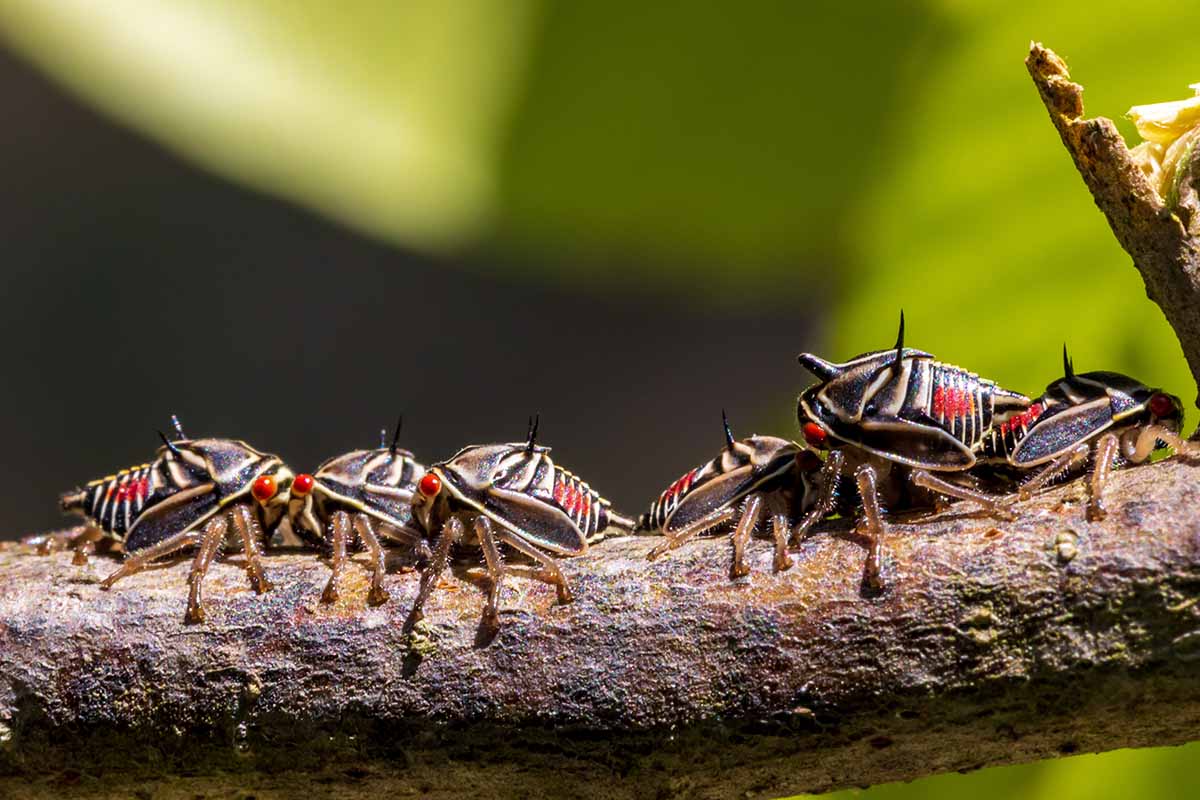
These insects have sucking mouthparts that they inject into the tree to suck out the sap.
Although they’re funky and maybe a little frightening to look at, they won’t seriously damage your tree, so don’t worry about treating them.
They can spread diseases but none that threaten willow oaks.
Oak Skeletonizers
Bucculatrix ainsliella, the oak skeletonizer, gets its name because the larvae of these moths feed on the underside of the leaves.
They leave behind just the veins and these transparent little “windows” of the leaf remain, like a skeleton. These leaves eventually dry up and drop.
On an established willow oak, you don’t need to do anything. But if more than half of the tree is defoliated, or if the tree is young or stressed already, you will need to treat it.
Bacillus thurengiensis v. kurstaki (Btk) is highly effective against the larvae.
Pick up a spray that contains this beneficial bacteria, like Bonide’s Thuricide.
It’s available at Arbico Organics in quart- and gallon-sized ready-to-spray options, or eight- and 16-ounce concentrate.
Spray the tree in late spring and again in late summer, in case there are two generations.
Disease
Oak trees can be susceptible to diseases, but willow oaks less so. They aren’t magic, though.
They can still contract diseases, but the infection probably won’t kill your tree.
Anthracnose
Anthracnose is a common disease in oaks, though it’s a bit less common in this species. It’s caused by the fungus Apiognomonia errabunda, which thrives in moist conditions.
At first, it causes small, water-soaked lesions that appear on the leaf margins or next to the leaf veins. These lesions gradually become gray and papery.
As new leaves emerge, they will be distorted or may drop off the branch before they can mature. You’ll usually see symptoms on the lower branches first.
Treatment is challenging. Since willow oaks are only mildly affected, you should avoid chemical treatments and opt for supporting your plant instead so it thrives despite the infection.
The spores can spread far and wide, which means even if you do get rid of anthracnose on your willow oak, it can come right back if a neighbor’s tree is infected.
The pathogens can also lie dormant inside a tree until favorable conditions return.
Keep your tree healthy with appropriate irrigation and remove all fallen material from around the tree to limit available options for the fungus to overwinter on.
Trim off any heavily symptomatic branches. Prune the canopy of the tree to open it up, which will let in more light with a buildup of less moisture, and thus create fewer places for the fungus to thrive on the lower part of the tree.
Canker
Caused by the fungus Polyporus hispidus, rapidly forming cankers develop that can grow up to six inches annually.
The same fungus can also produce large mushrooms attached to the trunk, and these are sometimes used medicinally. But when they cause cankers, they can kill a tree.
The fungus tends to infect heartwood, causing it to rot and turn black. It can also cause rot in the cambium or sapwood. Growth above the canker dies.
Chemicals are not effective in treating this disease. Cut off symptomatic branches and monitor the tree for additional symptoms. Trees with cankers on a majority of the branches should be culled.
Chestnut Blight
I know, with a name like chestnut blight, you’d think that this would only be a problem for chestnut trees. Nope. It can infect willow oaks, too.
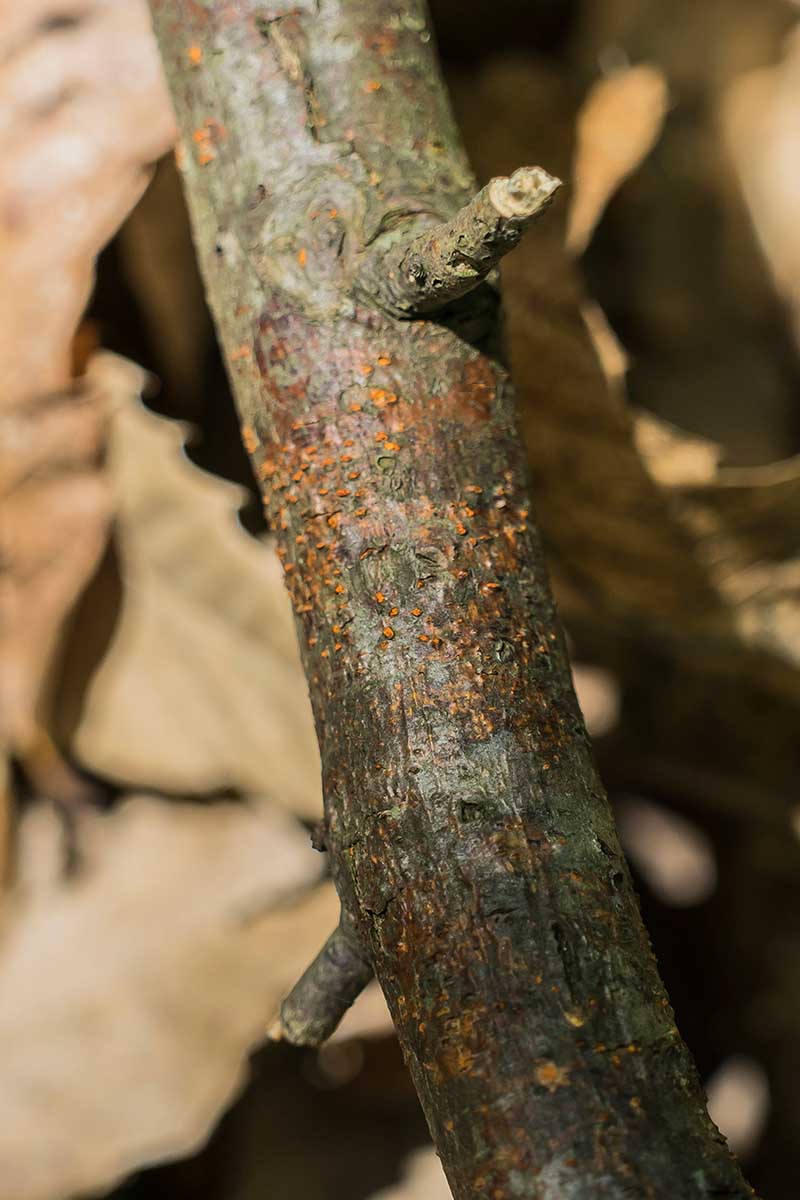
It’s caused by the fungus Cryphonectria parasitica, the same pathogen that killed almost all of the native chestnut trees across North America in just 50 years.
That’s four billion trees lost in just a few decades.
Oaks are a host of the pathogen, but it won’t kill them. It will, however, cause the bark to turn orange and sunken cankers to form.
Spread by wind and rain, it’s hard to control, obviously, since it decimated so many trees. But Dr. Wayne Weidlich, a botanist at Michigan State University, noticed in the late ‘70s that the roots of some chestnut trees were exposed by the construction of a logging road.
These roots had cankers, which doesn’t usually happen; cankers develop on the above-ground parts. This led Weidlich to hypothesize that the soil itself prevents the cankers from developing.
So, along with MSU researchers and Dr. William MacDonald from West Virginia University, he experimented with using the soil to cure cankers, and it worked.
If you see cankers on your tree, grab some native soil that hasn’t been treated with pesticides or herbicides and put it in a bucket. Add some water to make a muddy slop.
Place this mud on a piece of plastic, like a garbage bag that has been cut open, and press the mud against the canker.
Tie the plastic in place with rope or tape. Leave it in place for a few months and add water if necessary to keep the mud wet. The mud needs to completely cover the entire canker.
After a few months, you can remove the plastic and the canker will have become sealed by the tree so it’s no longer an open wound.
Shoestring Rot
Shoestring rot, also known as Armillaria root rot, is a disease caused by Armillaria mellea fungi that infects the roots of trees, but it doesn’t stay there.
As it progresses, it moves into the cambium of the tree and kills that. Eventually, the entire tree fails.
As with many diseases that affect the roots, you won’t know anything is wrong until the symptoms start to appear above ground. In this case, it’s the leaves that tell the tale.
They will be pale and smaller than usual, and they will drop prematurely.
There is no effective treatment. If your specimen is confirmed to have this disease, you can support it with proper watering and care, but it’s usually best to just remove it.
Best Uses for Willow Oaks
If you’re looking for a shade tree, stop – you’ve found the perfect one!
This is also a good option for parking lots, along streets, and buffer strips because of its upright habit and because it isn’t particularly messy.
Choose one of the very upright cultivars that we described above if you want a tree for one of these areas.
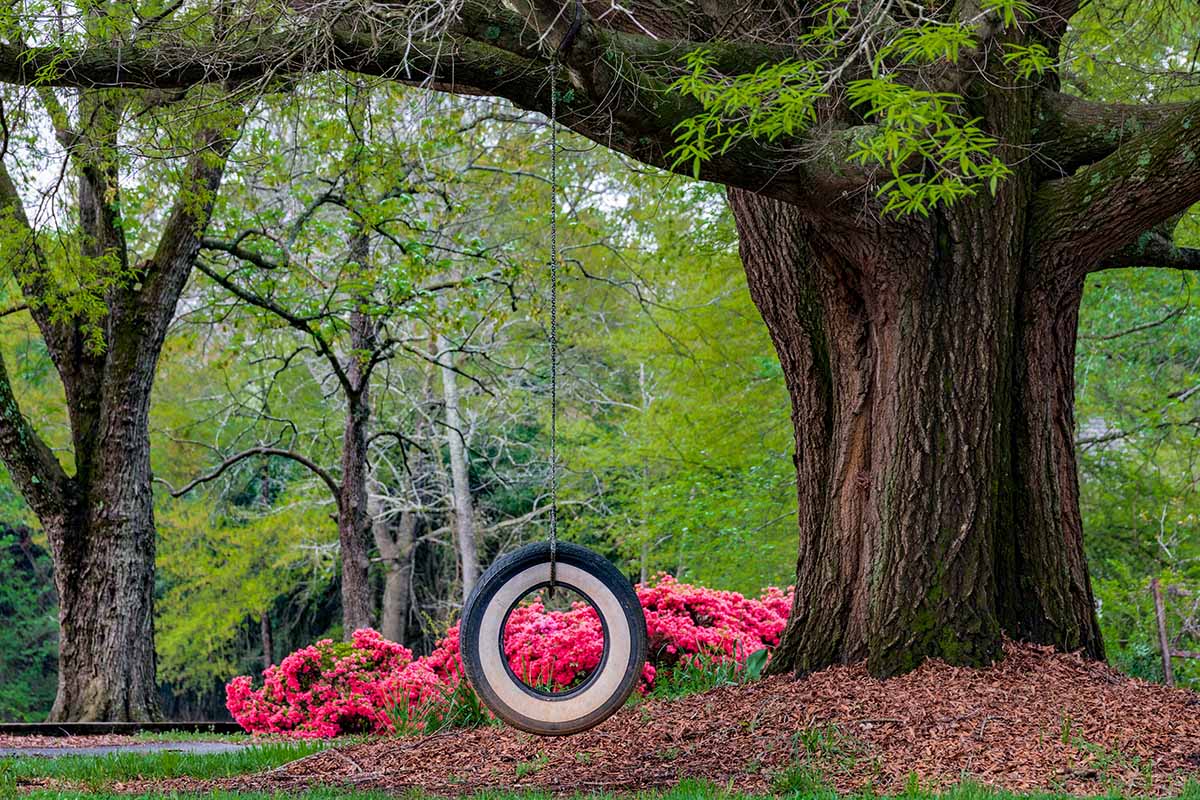
It’s not such a good bet if you have horses, however. The trees contain tannins and gallotannins which can be toxic if consumed in large quantities.
On the other end of the spectrum, animals like squirrels, mice, and birds such as nuthatches, jays, woodpeckers, titmice, and turkeys rely on willow oaks for food.
The willow oak is also valued for its pulp. And it may be used to restore bottomlands and disturbed areas in its native regions.
Grow it with American persimmons (Diospyros virginiana), other oaks, spruce pines (Pinus glabra), dogwoods (Cornus spp.), and hawthorns (Crataegus spp.).
If you opt to use the acorns, wait until they fall to the ground and check to see if a cap detaches easily. If it doesn’t, this means the acorn didn’t mature fully.
Quick Reference Growing Guide
| Plant Type: | Deciduous shade tree | Foliage Color: | Green |
| Native to: | Eastern North America | Maintenance: | Low |
| Hardiness (USDA Zone): | 5-9 | Tolerance: | Freezing temperatures, some drought |
| Season: | Spring, summer, fall | Soil Type: | Slightly sandy to slightly clayey soil |
| Exposure: | Full sun | Soil pH: | 4.5-5.5 |
| Time to Maturity: | 15-20 years | Soil Drainage: | Well-draining |
| Planting Depth: | 2 inches (seeds), roots just under soil (transplanting) | Attracts: | Birds, butterflies, hogs, moths, squirrels |
| Spacing: | 20 feet | Companion Planting: | Dogwoods, hawthorns, oaks, persimmons, spruce pines |
| Height: | Up to 100 feet | Uses: | Buffer strips, shade, parking strips, parking lots |
| Spread: | 40 feet | Family: | Fagaceae |
| Water Needs: | Moderate | Genus: | Quercus |
| Common Pests and Disease: | Borers, leafhoppers, oak skeletonizers; Anthracnose, canker, chestnut blight, shoestring rot | Species: | Phellos |
You Will Love Willow Oaks
When I picture the perfect afternoon, it involves laying under a big old tree during the summer with a good book.
A willow oak definitely fits the bill as the idyllic shade tree. But it also works in places as varied as parking strips and wildlands in need of restoration. And when you plant one, the local wildlife will thank you.
How do you plan to grow yours? Share your big plans in the comments section below.
There’s lots more fun in the Quercus genus to be had. If this guide helped you feel confident growing this species, you might want to read these other oak tree guides next:



